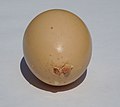Eggshell
Eggshell is the outer covering of a bird's egg, made primarily from calcium carbonate. It serves as a protective barrier against physical damage and also helps to prevent the entry of bacteria and other harmful organisms. The eggshell is porous, allowing for the exchange of gases between the inside of the egg and the outside environment.
Structure and Composition[edit]
The eggshell is composed of several layers. The outermost layer, or cuticle, is a thin coating that helps to prevent contamination by bacteria. Beneath the cuticle is the main shell, which is made up of calcite crystals. The innermost layer, or membrane, is made of proteins and provides additional protection for the egg contents.
Formation[edit]
The formation of the eggshell takes place in the oviduct of the bird. The process begins with the secretion of a protein-rich substance that forms the inner membrane. This is followed by the deposition of calcium carbonate to form the main shell. The cuticle is added last, just before the egg is laid.
Variations[edit]
Eggshells vary in thickness, color, and texture among different species of birds. These variations are influenced by factors such as diet, age, and environmental conditions. Some birds, such as chickens, lay eggs with hard shells, while others, like ducks, lay eggs with softer shells.
Uses[edit]
Eggshells have many uses. They are often used as a source of calcium in animal feed. They can also be used in gardening as a natural pesticide or as a soil amendment to add calcium. In addition, eggshells are used in various crafts and art projects.
Health Risks[edit]
Consuming contaminated eggshells can pose health risks, as they can harbor bacteria such as Salmonella. Therefore, it is important to handle and cook eggs properly to reduce the risk of foodborne illness.
See Also[edit]
Ad. Transform your life with W8MD's Budget GLP-1 injections from $75


W8MD offers a medical weight loss program to lose weight in Philadelphia. Our physician-supervised medical weight loss provides:
- Weight loss injections in NYC (generic and brand names):
- Zepbound / Mounjaro, Wegovy / Ozempic, Saxenda
- Most insurances accepted or discounted self-pay rates. We will obtain insurance prior authorizations if needed.
- Generic GLP1 weight loss injections from $75 for the starting dose.
- Also offer prescription weight loss medications including Phentermine, Qsymia, Diethylpropion, Contrave etc.
NYC weight loss doctor appointmentsNYC weight loss doctor appointments
Start your NYC weight loss journey today at our NYC medical weight loss and Philadelphia medical weight loss clinics.
- Call 718-946-5500 to lose weight in NYC or for medical weight loss in Philadelphia 215-676-2334.
- Tags:NYC medical weight loss, Philadelphia lose weight Zepbound NYC, Budget GLP1 weight loss injections, Wegovy Philadelphia, Wegovy NYC, Philadelphia medical weight loss, Brookly weight loss and Wegovy NYC
|
WikiMD's Wellness Encyclopedia |
| Let Food Be Thy Medicine Medicine Thy Food - Hippocrates |
Medical Disclaimer: WikiMD is not a substitute for professional medical advice. The information on WikiMD is provided as an information resource only, may be incorrect, outdated or misleading, and is not to be used or relied on for any diagnostic or treatment purposes. Please consult your health care provider before making any healthcare decisions or for guidance about a specific medical condition. WikiMD expressly disclaims responsibility, and shall have no liability, for any damages, loss, injury, or liability whatsoever suffered as a result of your reliance on the information contained in this site. By visiting this site you agree to the foregoing terms and conditions, which may from time to time be changed or supplemented by WikiMD. If you do not agree to the foregoing terms and conditions, you should not enter or use this site. See full disclaimer.
Credits:Most images are courtesy of Wikimedia commons, and templates, categories Wikipedia, licensed under CC BY SA or similar.
Translate this page: - East Asian
中文,
日本,
한국어,
South Asian
हिन्दी,
தமிழ்,
తెలుగు,
Urdu,
ಕನ್ನಡ,
Southeast Asian
Indonesian,
Vietnamese,
Thai,
မြန်မာဘာသာ,
বাংলা
European
español,
Deutsch,
français,
Greek,
português do Brasil,
polski,
română,
русский,
Nederlands,
norsk,
svenska,
suomi,
Italian
Middle Eastern & African
عربى,
Turkish,
Persian,
Hebrew,
Afrikaans,
isiZulu,
Kiswahili,
Other
Bulgarian,
Hungarian,
Czech,
Swedish,
മലയാളം,
मराठी,
ਪੰਜਾਬੀ,
ગુજરાતી,
Portuguese,
Ukrainian








